I have been exploring Barcelona Spain and its beautiful architecture for a few months. Last month I focused on the Magic Square located in the Passion Façade of the Sagrada Familia temple. It appears to be rather out of place and extremely odd. I have investigated (to a limited degree) the possible mathematical interpretations. My knowledge of Magic Squares is limited, so much so that I am not sure that the square in question is indeed magical. I have not solved the meanings in the Square, but I have discovered some interesting facts and have developed some intriguing speculations. I would like to share them and ask for feedback.
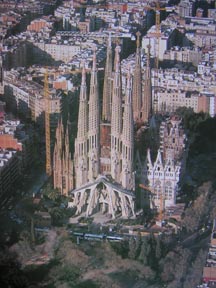 |
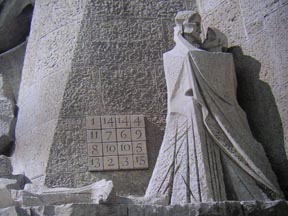 |
Josep Maria Subirachs (Barcelona, 1927) is the creator of numerous public monuments, including the famous Passion Façade of the temple of the Sagrada Familia. Subirachs is one of the most famous sculptors in Spain. The first photo below is the famous copperplate engraving named “Melancholia I” by Albrecht Dürer in 1514 (he became very interested in the relationship between mathematics and art). The Subirachs bronze engraving in the center displays a portion of the Dürer Magic Square. The photo on the right is of another Subirachs work. It contains the Dürer square rotated 180˚, with four values reduced by one. This produced a square with a Magic Sum of 33 (the age of Christ at his death), but resulted in the duplication of numerals 10 and 14, and the elimination of 12 and 16. Subirachs included this Magic Square in the Passion Façade of the Sagrada Familia.
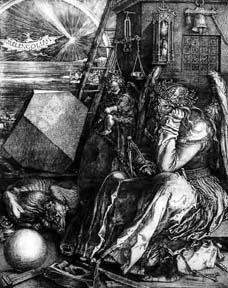 |
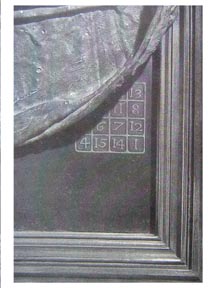 |
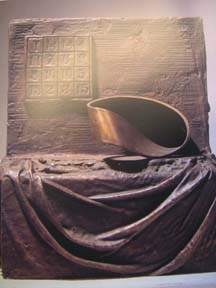 |
The first table below is the Dürer Magic Square with a Magic Sum of 34. The blue and green numbers to the right and below the table are a few of the Magic Sum results. The second table is the Dürer Magic Square after it has been rotated 180˚. The Magic Sum results confirm that the rotation has not affected the Magic in the square. The third table is the resulting Subirachs square. The blue numbers within the table have been reduced by one, from the values in the Dürer Magic Square. The numbers that were altered were carefully chosen to affect the Magic Sums of the rows, columns, diagonals, and internal squares by only one. This produced a Magic Square with a Magic Sum of 33. The Magic Sum results confirm that this manipulation has not dramatically affected the degree of Magic in the square. The magic has however been reduced (and perhaps eliminated) by the duplicated numbers 10 and 14 (shown in yellow) and the elimination of numbers 12 and 16 (shown in pink).
Dürer’s Magic Square Dürer’s Square Rotated 180˚ Subirachs’ Square
|
|
|
|
|
34 |
|
|
|
|
|
34 |
|
|
|
|
|
33 |
|
16 |
3 |
2 |
13 |
34 |
|
1 |
14 |
15 |
4 |
34 |
|
1 |
14 |
14 |
4 |
33 |
|
5 |
10 |
11 |
8 |
34 |
|
12 |
7 |
6 |
9 |
34 |
|
11 |
7 |
6 |
9 |
33 |
|
9 |
6 |
7 |
12 |
34 |
|
8 |
11 |
10 |
5 |
34 |
12 |
8 |
10 |
10 |
5 |
33 |
|
4 |
15 |
14 |
1 |
34 |
|
13 |
2 |
3 |
16 |
34 |
16 |
13 |
2 |
3 |
15 |
33 |
|
34 |
34 |
34 |
34 |
34 |
|
34 |
34 |
34 |
34 |
34 |
|
33 |
33 |
33 |
33 |
33 |
Here are three additional modifications to the Dürer Magic Square that produce Magic Sums of 33. The coloring convention is the same as that described above, with the addition of the red coloring of the cell containing zero.
|
|
|
|
|
|
33 |
|
|
|
|
|
33 |
|
|
|
|
|
33 |
|
|
1 |
13 |
15 |
4 |
33 |
|
0 |
14 |
15 |
4 |
33 |
|
1 |
14 |
15 |
3 |
33 |
|
|
12 |
7 |
6 |
8 |
33 |
|
12 |
7 |
5 |
9 |
33 |
|
12 |
6 |
6 |
9 |
33 |
|
14 |
8 |
11 |
9 |
5 |
33 |
6 |
8 |
11 |
10 |
4 |
33 |
8 |
7 |
11 |
10 |
5 |
33 |
|
10 |
12 |
2 |
3 |
16 |
33 |
2 |
13 |
1 |
3 |
16 |
33 |
4 |
13 |
2 |
2 |
16 |
33 |
|
|
33 |
33 |
33 |
33 |
33 |
|
33 |
33 |
33 |
33 |
33 |
|
33 |
33 |
33 |
33 |
33 |
Below are two more alternatives of which I assume Subirachs was aware. I can find no Subirachs interview or paper where he directly discusses the Square. Apparently, his major objective was to obtain a square with a Magic Sum of 33. The first square below is the most straightforward way that this can be accomplished. It has no duplicated numbers, contains the digit zero (a most dangerous number from a religious perspective because it quickly leads to the dreaded void and eventually to infinity), and does not contain the number four. The center table below contains perhaps the most perfect (or so I’ve been told) 4x4 Magic Square in existence. This perfect square can be transformed into a square with a Magic Sum of 33 using a similar technique to that described above. The right hand table below was produced in this manner. It is superior to the Subirach square in that it has only one set of duplicated numbers, and only one eliminated number. Subirachs instead chose the square with duplicated 10 and 14, and missing 12 and 16, even though there were numerous alternatives, some with superior qualities. Its possibly he chose it solely because of the Dürer connection.
Alternative 4 to Subirachs A very Magic Square Alternative 5 to Subirachs
|
|
|
|
|
|
33 |
|
|
|
|
|
34 |
|
|
|
|
|
33 |
|
|
0 |
5 |
12 |
16 |
33 |
|
7 |
12 |
1 |
14 |
34 |
|
7 |
11 |
1 |
14 |
33 |
|
|
15 |
11 |
6 |
1 |
33 |
|
2 |
13 |
8 |
11 |
34 |
|
2 |
13 |
8 |
10 |
33 |
|
|
10 |
3 |
13 |
7 |
33 |
|
16 |
3 |
10 |
5 |
34 |
|
16 |
3 |
9 |
5 |
33 |
|
4 |
8 |
14 |
2 |
9 |
33 |
|
9 |
6 |
15 |
4 |
34 |
12 |
8 |
6 |
15 |
4 |
33 |
|
|
33 |
33 |
33 |
33 |
33 |
|
34 |
34 |
34 |
34 |
34 |
|
33 |
33 |
33 |
33 |
33 |
The fascination that Subirachs has for this Magic Square can be appreciation, from the photos below. On the left is a representation of his desk. The center photo is the sculptor pondering his bulletin board at Sagrada Familia. He lived there for many years while working on the Passion Façade. The last photo is a note, written in Catalan, discussing the INRI conjecture, a popular speculation (which I find to be an extreme stretch of the imagination) about this cryptogram. It involves the 2 repeated numbers, 10 and 14. Adding these four numbers together, the resulting sum is 48 (10+10+14+14). 48 is also the resulting sum when the letters of the word INRI (in the Latin alphabet) are mathematically calculated:
|
A |
B |
C |
D |
E |
F |
G |
H |
I |
K |
L |
M |
N |
O |
P |
Q |
R |
S |
T |
V |
X |
Y |
Z |
|
1 |
2 |
3 |
4 |
5 |
6 |
7 |
8 |
9 |
10 |
11 |
12 |
13 |
14 |
15 |
16 |
17 |
18 |
19 |
20 |
21 |
22 |
23 |
I N R I (9+13+17+9=48). INRI is Latin for “Iesus Nazarenus Rex Indaeorum”, or Jesus of Nazareth King of the Jews. When asked about this speculation, Subirachs comments anecdotally: "maybe it's to remind me that I didn't put the word INRI on the cross' crown.”
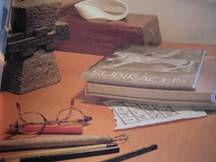 |
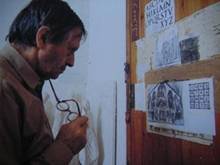 |
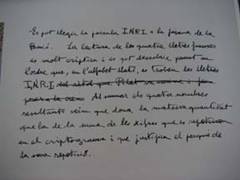 |
I wish to be very careful with this next line of reasoning. Gaudí is being considered for Sainthood. Here is a quote from a newsletter of the Gaudí Club of Barcelona.
“The Vatican has authorized the commencement of the diocesan process that may lead to the sanctification of Antonio Gaudí, the modernist architect who began the construction of the "Templo de la Sagrada Familia" in Barcelona. The authorization came from the Congregation for the Causes of the Saints, and was issued only two and a half months after the Cardinal Archbishop of Barcelona, Ricard M. Carles, formally requested that the Holy See open the case.”.
I know that much discussion is taking place about the worthiness of Gaudí. Visits are being made regularly to the Vatican by people familiar with Antoni Gaudí. I do not wish to suggest that Gaudí had Masonic connections, (this would not go well with the Vatican beatification process) and have no reason to believe that Gaudí was anything other than an extremely dedicated Catholic.
Gaudí's vision for the Sagrada Familia incorporated much symbolism. I’ll explore briefly the possibility of occult meanings in the Magic Square. Ten, the base for our numbering system, holds special mathematical significance and is at the heart of our scientific descriptions of nature. Fourteen, is the period of two weeks, half the lunar cycle; holds special astrological significance and is at the heart of our calendar and astronomy perspectives. Thirty-Three is one of the most powerful numbers of the mystical occult. A general practice of numerical composition in medieval literature was based upon lines of tradition that had come down through Pythagoras in classical antiquity. They came from earlier (but uncertain) sources, emanating from Egypt or Sumer and Babylon. The use of secret, symbolically ciphered numbers throughout the Bible is well-established, as reflected by Saint Augustine's extensive speculations on the mystical meanings of 33 (as the number of years in the life of Christ), or the 153 fish that Peter caught (John 21:11). To explain these requires a very far-fetched arrangement of number values with associated symbolic concepts. Masons and other occultists revere the number 33 above all other numbers. Many acts of war, murder, and assassinations have occurred on or near the 33rd degree parallel. Baghdad Iraq is located on the 33rd North parallel. This was the first major city to be established simply because it was on the 33rd Degree Parallel. Here is a portion of an article that asserts a Gaudí/Masonic connection (from http://www.gaudiclub.com/ingles/i_links/i_maso.htm).
“Park Güell is full of signs, which show that Gaudí and his patron, Eusebi Güell, were members of a Masonic lodge”. This is the thesis of the book "Park Güell. Utopia de Gaudí," which Josep M. Carandell recently published by the Triangle/Postals publishing house, is a detailed description of Gaudí's famous monument, illustrated with photographs by Pere Vivas. The thread of Carandell's text, is that the construction of the park, funded by patron and industrialist Eusebi Güell from 1910-14, was much more than a project to build a park-colony in which 40 houses would be built for around 400 inhabitants. The park contains numerous iconographic elements that indicate that both the architect and his sponsor belonged to a Masonic lodge, and that the park was the place where its members lived and met.
I personally find the arguments of this book to be very weak and contrived.
The next three photos relate to the arrangement of the 16 scenes comprising the Passion Façade. The Magic Square is located on the wall behind the “Kiss of Betrayal” (lower level, center section, left side), the third scene.
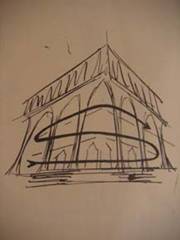 |
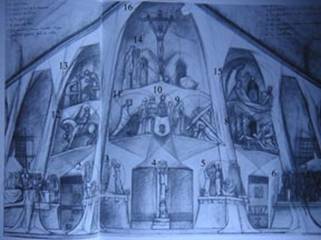 |
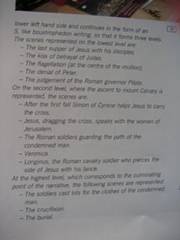 |
Below are the results of my effort to organize the scenes and to list the symbolisms contained within them. It should be noted that a temple of this faith has a long history of providing an educational platform for peasants unable to read. It therefore contains many symbolic and mystic elements, whose purpose are to stimulate religious thought and to serve as an educational tool. The number of scenes can readily be set at 16, one for each cell of a 4x4 matrix. These observations leads to my last speculation.
Scene Framing
The inclined columns are human bones, tibias
(1) The Last Supper of Jesus with his disciples
Dog
Window above the scene
St Matthew looks like Joan Maragall, benefactor of Gaudí
Unusual table arrangement, not all on the same side
One guest looks a lot like Gaudí
Doorway behind the scene
Their faces and comportment depict confusion and despair. Judas is represented with the bag of money. There is a little dog behind him. The fidelity of the animal is in contrast with the infidelity of the disciple. The following words are written on the tablecloth: 'El que estas fent fes-ho depressa' ('What you are doing, do quickly'), Jesus' words to Judas who was about to betray him.
(2) Peter cuts off ear of servant
Two Roman guards
Peter on the ground with sword
On the right, Peter has cut off the ear the High Priest's servant, and has fallen to the ground holding the sword.
(3) The kiss of betrayal of Judas
Magic Square on the wall
The Kiss
Snake
Doorway behind the scene
Judas, tempted by the devil (represented by a serpent behind him), betrays Jesus with a kiss.
(4) The flagellation (at the center of the mullion)
Rope representing bondage
Rod representing Abuse
Three Steps representing three days to Resurrection
Four drums representing the arms of the cross
NOTE: a fossil of type Margallo was found on one of the drums
Shifted drum representing changes social ethics
Alpha-Omega design on wall representing the beginning and end
Doorway behind the scene
The fossil is of a palm branch, symbol of the victory of the martyr.
(5) The denial of Peter
Rooster
Three figures representing the questioners
Agonizing Peter
Labyrinth
(6) The judgment of the Roman governor Pilate
Two Roman soldiers behind Jesus
Pilate agonizing over decision
Doorway behind the scene
Pilate, troubled and doubting, is seated next to Jesus crowned with the thorns and holding the cane with which he was struck on the head.
(7) The washing of hands and offer of criminal substitute
Eagle symbolizing authority
Roman soldier in wall
Pilate washing hands
Two persons attending
Window above
First Station of the Cross
Pilate, with the Imperial Eagle behind him, is asking the crowd what to do with The Man.
(8) After the first fall, Simon of Cyrene helps Jesus to carry the cross
Fallen Jesus
Simon lifting cross
Three persons watching
Fifth Station of the Cross
Jesus has fallen for the first time. The women of Jerusalem cry for him and Simon of Cyrene helps him to carry the cross.
(9) Jesus, dragging the cross, speaks to the women of Jerusalem
Large group of Women
Eighth Station of the Cross
Telling the women of Jerusalem not to cry for him
(10) Veronica
Faceless, symbolizing that her legend was not in the bible
Veil with negative face
Sixth Station of the Cross
As a legendary figure (she is not in the Gospels), she is featureless.
Veronica is holding the cloth with the imprint of Jesus' face.
(11) The Roman soldiers guarding the path of the condemned man
Two Roman guards
Model of Gaudí as an evangelist recording the event
To the left is an old man in profile. It is Antoni Gaudí. Gaudí is taking notes - therefore he is represented as the evangelist who then puts the Gospel into stone.
(12) Longinus, the Roman cavalry soldier who pierces the side of Jesus with his lance
The lance has pierced the rock above
The lance pierces the wall of the church, representing the body of Christ.
(13) The soldiers cast lots for the clothes of the condemned man
Three Roman guards
Tenth Station of the Cross
On a table that is made taking a genuine human vertebra as a model.
(14) The crucifixion
Unusual cross with no INRI
Full moon representing Easter
Three figures, representing Mother Mary, John the Baptist, and Mary Magdalene.
Skull representing death
Naked Jesus representing Nature
Large rock
Eleventh Station of the Cross
At the foot of the cross, is Mary Magdalene kneeling on the ground, Mary, the mother of Jesus and John the Evangelist.
Adam's skull is the symbol of mortal humanity. On the top are a cross, the empty tomb and two sets of stairs with columns descending from the empty tomb to symbolize Christ's descent into hell. On the two set of stairs are the Patriarchs and the Prophets.
(15) The burial
The virgin in the background
Egg for a halo, symbolizing rebirth
Joseph of Armathaea at one head of body
Nieodemus at feet of body – looking like Subirachs the sculptor
Fourteenth Station of the Cross
The hand of the sculptor is magnified, and the initial 'S' is carved into the stone. An egg is placed above her head: it is a symbol of the Resurrection, of the sealed sepulcher from which Christ emerges alive.
(16) The resurrection
Fifteenth Station of the Cross
Above the cross is the veil of the Temple that was torn in two when Jesus expired. A mosaic is visible through the torn veil, where a scene from the Celestial Jerusalem is represented: the lamb that was slain, standing in front of God's throne: slain and standing.
If you substitute the scene names for the numbers in the Subirachs Magic Square,
|
|
1 |
14 |
14 |
4 |
|
|
11 |
7 |
6 |
9 |
|
12 |
8 |
10 |
10 |
5 |
|
16 |
13 |
2 |
3 |
15 |
you get:
|
LastSupper |
Crucifixion |
Crucifixion |
Flagellation |
|
Guards |
WashingHands |
Judgment |
SpeaksToWomen |
|
Simon |
Veronica |
Veronica |
PeterDenial |
|
Gambling |
PeterEar |
JudasKiss |
Burial |
The missing scenes are Longinus (12) and Resurrection (16). This does not clear anything up for me, but may provide that Aha-Hah experience for someone closer to the subject. I am not of the Catholic faith and have no extensive understanding of the Passion mythology. The Crucifixion and Veronica scenes are in the central positions of the Façade. The Veronica story is very unusual in that it a recent addition to the myth, and continues to be controversial. Perhaps adding the scene elements in a similar way to adding the numbers in a Magic Square will suggest something to a person more versed in the underlying story lines. I suspect that the Magic Square was a working template for Subirachs while designing the façade. For some people, these numbers play an important role in their life. They will choose what house they live in, what slots they play or what date they will or won't do something based on them.
I continue to be at a loss to explain the meaning of the Sagrada Familia, Passion Façade, Magic Square. Yet, I continue to be intrigued, and offer my time to help investigate any speculations that the information above may suggest.
George Zimmerman, at GZimmerman0@Earthlink.Net